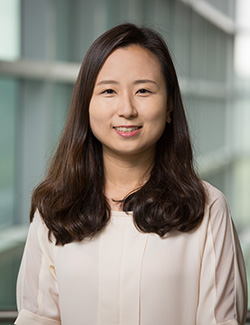Grace Han’s Brandeis Breakthroughs Continue to Shape Interdisciplinary Chemistry

Before joining the faculty at the University of California, Santa Barbara, Grace Han made her mark as an Assistant Professor of Chemistry at Brandeis University, where she led pioneering research at the intersection of chemistry and engineering. Her lab, known for tackling practical global challenges through creative molecular solutions, was recognized early in her Brandeis tenure with two prestigious Sprout Awards as well as an NSF I-Corps™ Fellowship.
The awarded projects exemplify Han’s interdisciplinary ethos: one developed a photo-switchable adhesive, while the other tackled the energy inefficiencies of engine oil heating in cold climates. Despite their differences, both technologies showcase her lab’s commitment to designing molecular systems that respond intelligently to their environments.
A graduate of MIT’s PhD program, Han chose to launch her academic career in the Boston area due to its vibrant research community and access to both analytical and fabrication tools. Brandeis stood out as a welcoming environment for early-career scholars. There, she quickly established a thriving lab that blended chemical synthesis with engineering applications, exploring how organic molecules behave under various stimuli—especially light.
The first of the lab’s Sprout-funded projects explored adhesives that change properties under targeted lighting. By designing molecules that respond to specific wavelengths, Han’s team created an adhesive capable of selective debonding—especially valuable for applications like microchip assembly and repair, where access under heat or pressure is challenging.
The second Sprout Award recognized the team’s work on passive thermal storage materials designed to keep engine oil warm in freezing conditions—without the use of electricity. The concept involved harvesting waste heat from a running engine and storing it in crystalline materials, which would then release that heat later to reduce friction at startup. This novel approach aimed to replace inefficient block heaters with sustainable, self-sufficient thermal systems.
The I-Corps Fellowship recognized a sustainable solar energy solution using Molecular Solar Thermal Energy Storage (MOST)—a novel, color-changing material that absorbs sunlight and stores it as heat. By applying MOST as a coating on surfaces like windows, Grace’s team explored how MOST could provide both aesthetic customization and efficient, on-demand heat release, offering a practical, energy-saving innovation for homes and buildings.
Han’s lab not only conducted leading-edge research, but also pursued real-world impact. One of her postdoctoral researchers participated in the Brandeis I-Corps program, a federally supported initiative to commercialize academic research. The team used this opportunity to analyze customer needs and explore potential markets for their innovations.
Han’s work at Brandeis also involved probing deeper questions about how molecular structures behave under stimuli. Using Transmission Electron Microscopy (TEM), her lab examined atomic-level motion during photo-switching—work that required access to high-powered instrumentation and synthetic materials that mimic organic systems. This research put her team on the map as pioneers in a highly specialized field that remains largely unexplored globally.
When asked to summarize her work in a single word, Han chose “control”—specifically, finding ways to master phenomena that traditional tools struggle to influence. Whether training light to perform useful tasks or designing molecules to behave in highly specific ways, her work during her time at Brandeis laid the foundation for a promising new chapter at UCSB.